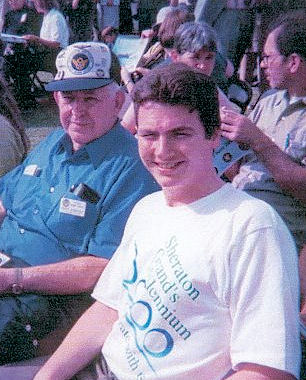
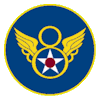

September 5, 2010
Volume II, Issue 13
www.303rdBG.com
Shot In The Elbow and Leg — And All Four Engines On Fire
by Arthur D. Tobkin
Nephew of S/Sgt Mathias J. Kremer
Revised from the article originally published in the May 2005 "Hell's Angels Newsletter"
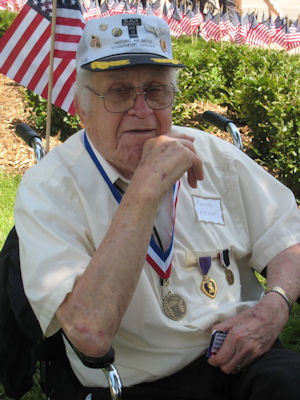 |
This story is dedicated to those aircrews and ground personnel who were a part of "Black Thursday"; and is especially dedicated to my Uncle S/Sgt Mathias "Matt" J. Kremer, Ball Turret Gunner, 358th Bomb Squadron, 303rd Bomb Group (Heavy), 1 Air Division; flying from the air base at Molesworth, England.
Schweinfurt, Germany, was the manufacturing site of approximately 40% of the ball bearing production for the Third Reich. The Allied Forces had flown the first mission to Schweinfurt on August 17, 1943. Of the 306 bombers that reached Schweinfurt on that day; and a second target at Regensburg, Germany, 60 aircraft were lost, along with approximately 600 aircrew men. The 8th Air Force was fully aware that they could not continue to experience the nearly 20% loss ratio of the Schweinfurt/Regensburg raid; however, the 8th Air Force was also fully aware of the importance of reducing the Schweinfurt production of bearings for the Third Reich.
As my Uncle Matt related to me:
"Our sixth mission was on October 14, 1943. We, the crew of our B-17, were awakened at about 4:00 a. m. It was time to shower and get to breakfast. We had to be at the briefing by 6:00 a. m. It was a dreary morning with fog and a slight mist in the air. After our breakfast, we all assembled in the briefing room. Everyone was talking and wondering where the mission would be.
The Briefing Officer soon arrived and got up on the stage by the big map of Europe. He uncovered the map - Schweinfurt was outlined. You could have heard a pin drop, it was so quiet. No one wanted to go to Schweinfurt, since we knew it was one of the most protected cities in Germany."
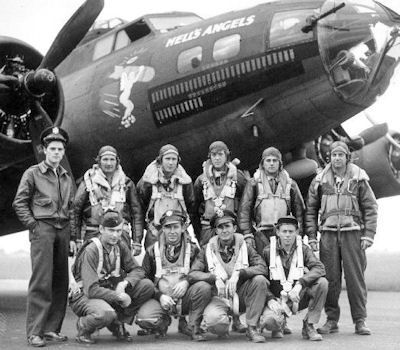 |
The escort fighters encountered the first enemy planes over Walcheren Island. At approximately 1330 hours, the fighters with limited fuel, turned back toward England. Uncle Matt's plane; the "Joan of Arc", was near the German border when the first German fighter attacks began. These attacks came from eastern Belgium and continued onward to the target at Schweinfurt, Germany.
In my Uncle Matt's own words:
"When our escort turned around to go back, the German planes came at us. They lined up out of reach of our guns. Then, ten or fifteen at a time, they would come in to attack us. I was in the ball turret. My intercom was shot out in about the second attack, so I was on my own down there. I had no idea what the crew on top was doing or what was happening in the plane. It was really lonesome in the turret without the chatter from the rest of the crew. The Germans kept up a steady attack. When one group finished with us, another group was waiting to take over from there. This was happening, along with the anti-aircraft shells from the ground, that were exploding around us. I saw plane after plane shot down. There were so many I lost count. Finally, after we had been in the air for about five or six hours, we spotted the target at Schweinfurt. We dropped our load of bombs on the target and were heading back to our base at Molesworth."As the "Joan of Arc" was turning toward England, it was hit by cannon fire from a German ME-210 or ME-410. The cannon shell impacted the B-17 in the tail of the aircraft, and the tail gunner, S/Sgt Alfred E. Cockrum; and the right waist gunner, Sgt Martin V. Carll were killed instantly. The cannon shell also caused the rudder and the horizontal stabilizer to jam and the aircraft was unable to continue its turn back toward England. Matt's plane was forced to drop out of the protective formation of bombers.
My Uncle Matt related:
"Now the pilot couldn't keep up with the formation, and we fell behind. That was when the Germans really came after us from all sides - left, right, top and bottom. I was firing at a plane coming in at me and it started to go down in smoke. I followed it with my turret to make sure I had gotten it. That is when a twenty millimeter shell came in behind me and went through my elbow and into my leg. Everything in the turret was bloody!"I turned in my turret seat so that I could climb up into the waist section of the plane with my right arm and leg. As soon as I got my eyes level with the floor of the plane, I realized that everyone was parachuting out. In the process of climbing out of the turret I had to remove my oxygen mask and we were at 26,000 feet altitude, so I needed to get out fast. I had to put on my parachute with just one hand; since my left hand was useless. I almost had it on when I was hit in the back with shrapnel from a shell. It knocked me down and I had to start over with getting the chute on my back. By now, all four engines were on fire and I knew they could blow up any time. I finally got my chute on and headed for the door. Just as I got to the door, I felt the plane start to nose dive. I jumped, and dropped about twelve to fifteen thousand feet before I opened my chute. While I was falling, a German kept circling me in a little fighter plane. When I opened my parachute, he saluted and left. By that time, I knew he had reported about where I would land."
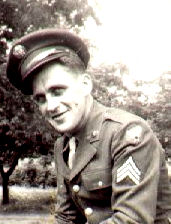 |
Uncle Matt had grown up in a household where German was spoken daily by his parents; therefore, he could understand the German language. He told me that when they got to town,
"they took me from the wagon and helped me to the aid station. Nearby, were about twenty German civilians in the street with guns and pitch forks. I heard one of them say in German, 'We should shoot the S. O. B. in the back.' The two German soldiers turned around, pulled their side-arms, and cleared the street. Then these two put me in the aid station and left me there. A little later, the pilot from my crew was brought in and the people giving first aid let us talk for about a minute. Then they took the pilot away. I lay there on the slab until after dark. That evening they hauled me to a nearby hospital where a German nurse gave me an injection of something."
Matt remained in the Bamberg* area for about a week. The German medical personnel put casts on his arm and leg, but did not clean or attend to his wounds. He was then moved to a former French hospital in Ludwigsburg, Germany; which is just north of Stuttgart, Germany. Here he was placed under the care of another prisoner; a Polish doctor by the name of Dr. Zenowski. The Doctor examined Matt, shook his head and told the orderly to put him "somewhere". The next morning, Doctor Zenowski, surprised that Matt was still alive, did a more thorough examination. He had to remove the casts on Matt's left arm and leg, clean the wounds, remove additional shrapnel, re-break his arm and install new casts.
In Uncle Matt's own words:
"About two weeks after I got to the hospital, my leg started to hurt real bad. Doctor Zenowski announced that he had to take off my leg, because it was gangrenous. He promptly took me to surgery at 0800 and at 0814 I woke up in my bed. The doctor explained that he had to work real fast because he couldn't give me much ether, since he was afraid the ether would kill me.During the summer of 1944, Matt was informed that he was to be one of the prisoners that were to be freed in an arrangement made through the Red Cross. He was to be part of an exchange of badly wounded prisoners. He was put on a train to Stockholm, Sweden then aboard the M. S. Gripsholm. He arrived in New York City approximately one year after he was shot down over Germany. At the Percy Jones Hospital in Battle Creek, Michigan, Matt was reunited with his wife and son. During his stay at Battle Creek he was outfitted with a prosthetic for his left leg. He was honorably discharged on Valentines Day, 1945."I was at this hospital for another month and then was scheduled to be moved to an American prisoner of war hospital at Meinagan, Germany. The day I was discharged, Dr. Zenowski looked at me for the last time and said; 'Matt, when they brought you in, I wouldn't have given two cents for your chances. But something kept you going.' I said to him 'I told my wife I'd be back and I couldn't lie to her. Anyhow, I didn't want to be buried in Germany'."
My Uncle Matt and Aunt Gerry went on to raise nine children. Aunt Gerry passed away in 1993 after 51 years of marriage. Matt retired from the Minnesota Department of Veterans Affairs and passed away in October 2009.
* This article was first published in the May 2005 issue of the 303rd Bomb Group Association's "Hell's Angels Newsletter." After the publication, I was contacted by a Mr. Norbert Vollman, who resides in Gerolzhofen, Germany, approximately 12 miles south of Schweinfurt, Germany. Mr. Vollman is a journalist who was working on an article concerning the crash sites of American Bombers during World War II. The original article referenced the book "Half a Wing, Three Engines, and a Prayer" which stated that Uncle Matt's plane went down near Bamberg, Germany (approximately 30 miles ESE of Schweinfurt). My Uncle Matt did not know the location where he landed after bailing out of his stricken bomber as the German authorities were non-communicative. Mr. Vollman's research indicated that the "Joan of Arc" crashed near the town of Sindringen, Germany; approximately 30 miles north of Stuttgart, Germany. Uncle Matt had indicated that he had been taken to a former French Hospital in Ludwigsburg, a suburb of Stuttgart. I had asked Uncle Matt about the trip from the crash site area to the Ludwigsburg hospital and he stated that it was by a horse drawn cart and took about a day. Since Sindringen is approximately 28 miles north of Ludwigsburg; this would substantiate the location of the crash of the "Joan of Arc" (a trip from the Bamberg area to Ludwigsburg would have been approximately 100 miles and would have been longer than one day in duration).
12 August 1943
Target: Geisenberg Benzine and Hydrogenation Synthetic Oil Refinery
at Gelsenkirchen, Germany
Into "Happy Valley" (Ruhr Valley) flew a formation of Flying Fortresses to mark the first heavy daylight bombing raid to the heart of the Ruhr. The bombers flew unescorted to the target area but were met on the return journey by P-47 "Thunderbolt" fighters. One 427th BS aircraft, #42-24619 S for Sugar (Lt. Shope), aborted after the No. 4 engine failed. The bombs were jettisoned in the wash.
Weather on the trip was fair with good visibility until the formation reached the target area. At the target flying at 27,000 feet, cloud cover, ground haze and smoke made it impossible for crews to observe the bombing results. However, the bombers had made a good run on the target with evasive action, dodging the most intense flak yet encountered. Later analysis indicated that no 8th Air Force bombers were successful in hitting the primary target.
No fighters attacked until the Fortresses dropped their 38 tons of 320 British 250-lb. incendiary bombs. As soon as they turned away from the target area, 100 to 150 FW-190s and ME-109s started to concentrate their attacks on the 303rd BG(H). The fight lasted 45 minutes with almost continuous attacks. Gunners claimed four destroyed, four probables and one damaged. The attack broke off when the P-47s appeared. Scattered flak was encountered at different stages of the journey, but the Ruhr Valley barrages were intense and accurate.
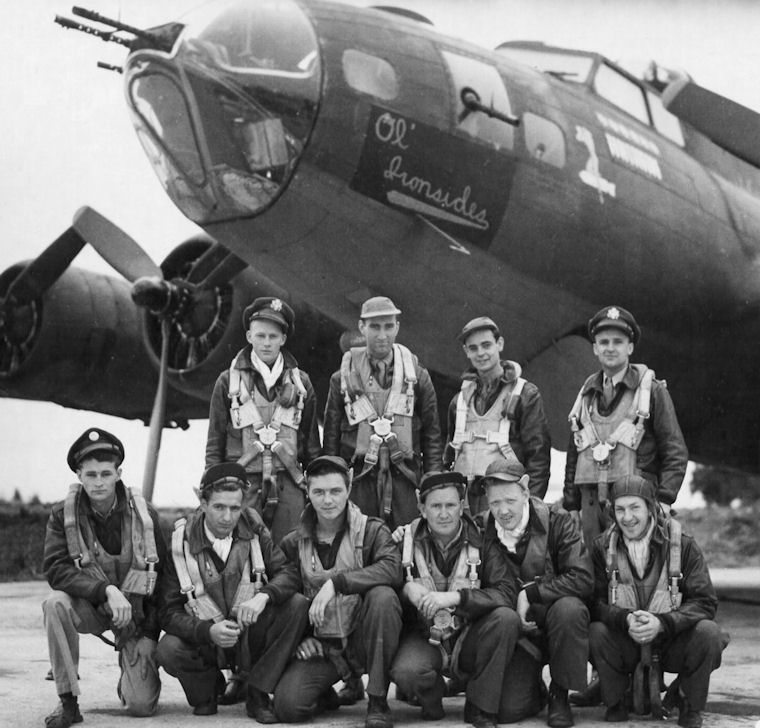
(Back L-R) 2Lt Norman N. Jacobsen (N), 1Lt Arthur H. Pentz (P)(POW),
F/O Harold S. Bolsover (CP), 2Lt Russell O. Philpit (B)(POW/Repr)
(Front L-R)
S/Sgt Hurd L. Edwards (BTG)(POW),
T/Sgt Robert L. Murray (R)(POW),
S/Sgt Robert J. Horvath (WG)(POW),
S/Sgt George E. Howard (WG)(POW),
S/Sgt William H. Bruns, Jr. (TG),
T/Sgt John A. "Jack" Dougherty (E)(POW)
Aircraft #42-29640 Old Ironsides 359BS, piloted by 1Lt. Arthur H. Pentz, was last seen at a point ten miles south of Hokum, Germany after dropping its bombs. It fell behind the formation after a fighter attack and was almost completely on fire. It crashed at Wuppertal, Germany. The navigator, 1Lt. Benjamin B. Street was killed in action. Lt. Pentz, 2Lt. Thomas E. Mulligan, 2Lt. Russell O. Philpit, T/Sgt. John A. Dougherty, S/Sgt. Robert A. Horvath, T/Sgt. Robert L. Murray, S/Sgt. Hurd L. Edwards, S/Sgt. Elmer T. Knudsen and S/Sgt. George Z. Howard were captured and became prisoners of war. 2Lt. Russell O. Philpit was later repatriated.
The 8th Air Force lost 25 of the 243 attacking aircraft–nearly a 10% loss rate. When questioned about the mission results, Maj. Calhoun said, "They had smoke all over the place. Don't know whether it was a smoke screen or results of RAF night bombing. Saw about 150 fighters. Some of the other boys caught hell. Before I say anything about the bombing, I want to see the pictures. Those P-47s sure looked good."
Capt. Yonkman, bombardier on The '8' Ball MK II remarked, "We had a good pattern, but there was so much smoke and clouds we couldn't see the hits."
Capt. Dave Rogan, pilot of Jersey Bounce, Jr. completed his 25th mission and commented, "I really sweated some today. Those boys in that territory don't fool around."
S/Sgt. Antonio Bednarchuk, tail gunner on Son also completed 25 missions and stated, "Happy Valley" is one place that a fellow is glad to get out of. Been here since the start and it's the roughest I've seen. The boys that say they are getting easier are crazy."
The '8' Ball MK II co-pilot 1Lt. James Nix added, "One fighter came barrelling in right through the formation. He wasn't 25 yards from us shooting away. Another blew the tail right off a Fortress in the Group ahead of us. A 'shaky do.'"
T/Sgt. James R. Welch, waist gunner of the 358th BS ship Meat Hound remarked, "My first trip was to Bremen and I thought it
was rough, but this tops 'em all. One more like that and I'll sit on the ground."
![]()
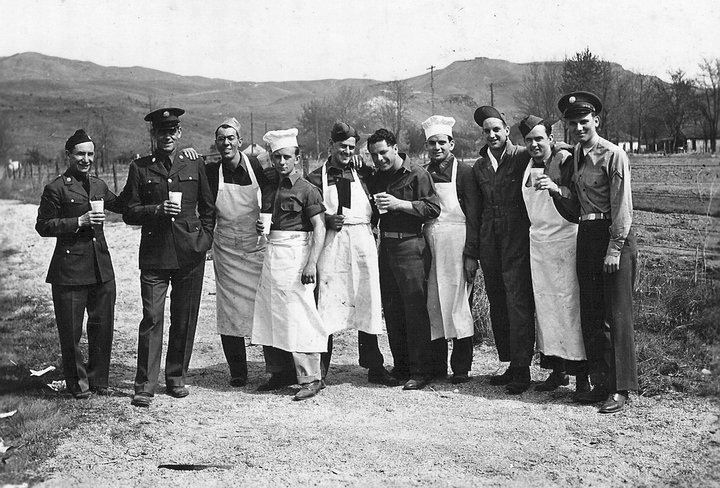
This photo is believed to have been taken in 1942 while the 303rd Bomb Group was at Gowen Field, Boise, Idaho.
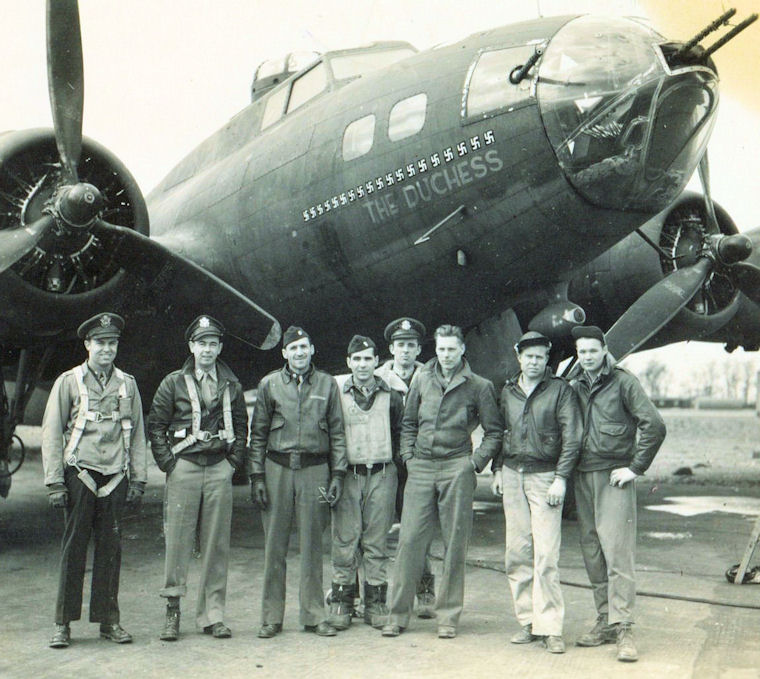
This photo, taken by 359th BS photographer T/Sgt William H. Green, shows the seldom seen starboard side of Duchess. 360th BS Pilot Capt Pharis Brinkley is second from the left. S/Sgt Harold C. Reid (BT) and T/Sgt Richard N. Snyder (R) are at the far right. The photo is courtesy of Robin Green, son of the photographer.
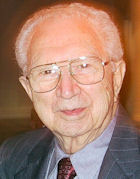 |
 Facebook's membership has grown to an astounding 500 million members. In a effort to encourage young, and the young-at-heart, generations to learn of the legacy of the 303rd Bomb Group, we have joined with them and now have a Facebook page. It is a very easy place to upload your 303rd BG photos to share. We hope you will join our Group on Facebook and enjoy an interactive experience with others who have the same interests.
Facebook's membership has grown to an astounding 500 million members. In a effort to encourage young, and the young-at-heart, generations to learn of the legacy of the 303rd Bomb Group, we have joined with them and now have a Facebook page. It is a very easy place to upload your 303rd BG photos to share. We hope you will join our Group on Facebook and enjoy an interactive experience with others who have the same interests.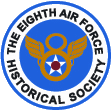
Many museums and historical organizations now have a Facebook presence, including The Eighth Air Force Historical Society. We encourage you to join them on Facebook, also.
![]()
Son of 303rd Pilot to Visit Former Crash Site
On February 22, 1944, while returning from a 303rd raid on Aschersleben, B-17F 42-5788, Pluto's Avenger of the 360th BS, already struggling from the loss of one engine, encountered a heavy fighter attack and was shot down near Duffel, Belgium, a town about 20 miles NE of Brussels. Six of the 11 crewmen bailed out; one died in hospital days later, 1 evaded capture, and 4 were captured. The pilot of Pluto's Avenger was John R. Morrin of Chicago, Ill. who survived the war, and passed away in 1985.
Last year, his son, Jim Morrin, discovered that an organization in Duffel (the Allied Remembrance Group - Duffel) had constructed a monument to the men of the Morrin crew who lost their lives that day. Jim contacted the president of the group and told him he would like to honor the group for their kindness to the families of the lost flyers. Jim is now planning to visit Duffel on September 19 to attend a presentation ceremony at the monument in the town. Jim is busy practicing a thank-you speech, which he translated into Flemish for the occasion. Jim has promised to take pictures of the event, and we will follow up in a future issue.
Preserving the 303rd BG Legacy: September Presentation at RAF Molesworth
Gary L. Moncur, 303rd Bomb Group Historian and son of 303rd Bomb Group pilot Vern L. Moncur, will be speaking to the men and woman currently serving in the Joint Analysis Center at RAF Molesworth on September 24, 2010. His topic will be, "The 303rd Bomb Group - Preserving the Legacy."
![]()
by Meg Godlewski
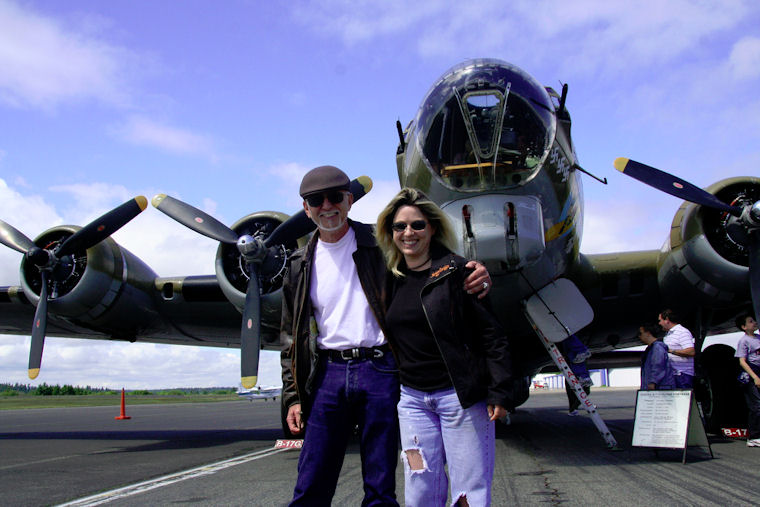
Jack Weaver and his daughter, Andrea Bradley, and the B-17 "Nine-O-Nine"
Every summer the Collings Foundation Wings of Freedom Tour visits airports around the country. The tour features World War II aircraft, including a B-25, B-24, and a B-17. Visitors are encouraged to make a donation and tour the airplanes on the ground. Others pony up $400 or so for a 20-minute flight in one of the bombers.
While some people may think that $400 for 20-minute airplane ride is foolish, for others it is a deep emotional experience, and a way to connect with long-lost family members. Like Jack Weaver, a passenger on a B-17 flight from Aurora, Ore., to Tacoma, Wash. His father, Jack W. Weaver, was a B-17 pilot during World War II, a member of the 303rd bomb group, 360th squadron based in Molesworth, England.
“He didn’t talk about his experiences much after the war,” says the younger Jack.
“My grandpa’s airplane didn’t have a name,” added Andrea Bradley, Jack’s daughter and Jack W.’s granddaughter, who accompanied her father for the ground tour of the B-17. “His focus was on getting his crew home safely.”
Jack W. passed a way a few years ago. For his son, the flight aboard the B-17 “Nine-O-Nine” was a way to reconnect with his father.
“I was trying to get a feeling of what it might have been like for him a little bit when he was up there,” he said. “We were not flying at high altitudes with no heat and we didn’t have big guns on the ground trying to shoot us down and we didn’t have German fighter planes in the air trying to do the same thing, but I think I got a little bit better idea.”
The Collings Foundation allows passengers to roam about the ship when the aircraft is in cruise flight. “It was great,” he said. “It was bumpy and noisy and windy and awesome!”
Jack W. flew approximately 28 missions during the war. His son followed in his footsteps to some extent, flying small airplanes and later becoming an air traffic controller at Sea-Tac Airport.
The aviation gene runs in the family, Weaver notes with pride. “Andrea learned to fly at the Tacoma Narrows Airport before she was old enough to drive and she’s just about to get her Airframe and Powerplant ticket from Clover Park Technical College. I’m hoping she’ll get back into flying.”
Andrea shares her father and grandfather’s passion for aviation, especially the World War II designs, saying, ”I think they are the most fantastic airplanes ever built and I don’t know if we can really come close to them with anything now.”
Part of the Collings Foundation experience is watching veterans of both the B-17 and the B-24 interact with the airplanes. It can be especially moving.
“I see what I am sure are a lot of heroes. I see a lot of men in tears, I see a lot of men looking at these aircraft and remembering the good times and, I am sure, bad times as well,” said Bradley. “I admit I got a little teary eyed when I watched the B-17 land. It makes me think of my grandpa.”
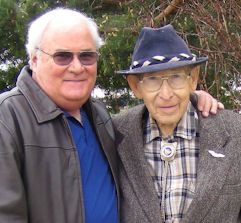 This photo of Jack Rencher and myself was taken on May 27th, 2010 at Gowen Field, Boise, Idaho. Three months and one day later, on August 28th, 2010, I stood alone in the viewing room at a Boise church and shared a private moment with him. I held his hand and said a final goodbye to one of the finest men I have ever known.
This photo of Jack Rencher and myself was taken on May 27th, 2010 at Gowen Field, Boise, Idaho. Three months and one day later, on August 28th, 2010, I stood alone in the viewing room at a Boise church and shared a private moment with him. I held his hand and said a final goodbye to one of the finest men I have ever known.
He looked very peaceful and content, still wearing his pilot's wings and his ever-present 8th Air Force bolo tie. The classic hat he is wearing in this photo was displayed amongst dozens of old family photographs and some WWII memorabilia. The church was overflowing with mourners, and those arriving late had a difficult time finding a seat. It was very obvious that Jack had a lot of friends.
We first met Jack in 1999 at the 303rd Bomb Group Reunion in Oklahoma City and quickly became fast friends. Earlier that year, his wife had passed away, as had his oldest son, Jack. He was also still recovering from a heart attack. Even through all that, he had a smile on his face, a sense of humor and a love for life. We had lunch with Jack and his family in Boise just three months ago. He was quiet and not feeling his best, but still had that captivating smile.
I was honored to represent Jack's many 303rd Bomb Group friends who were unable to attend his Memorial Service. It was my privilege to help carry his casket and to stand at attention at his gravesite as an Air Force bugler played TAPS. "Goodbye old friend, until we meet again. We will never forget you."
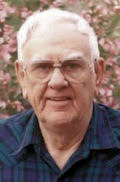 Duane M. Braun, beloved father, husband, friend and war hero, passed away Monday morning, August 30, 2010, at Spanish Meadows retirement community in Katy, Texas, following a long, courageous and mostly happy struggle with a broken hip, failing heart, and pneumonia. Duane, affectionately known as "Poppa" and "Daddy" in his later years, was 89 years old.
Duane M. Braun, beloved father, husband, friend and war hero, passed away Monday morning, August 30, 2010, at Spanish Meadows retirement community in Katy, Texas, following a long, courageous and mostly happy struggle with a broken hip, failing heart, and pneumonia. Duane, affectionately known as "Poppa" and "Daddy" in his later years, was 89 years old.
Duane lived a quintessential 20th Century American life. He was born during the Roaring Twenties (May 2, 1921) on his beloved rural family farm at Bonus in Wharton County, located outside the rice farming and goose hunting community of Eagle Lake, Texas. He survived a difficult childhood (which included military school, witnessing the drowning/electrocution death of his father, and the Great Depression) to join the military in 1940 before the outbreak of World War II.
Duane was assigned to the Eighth Army Air Force, 303rd Bomber Group, England, where he became a bona fide war hero in the defeat of Nazi Germany. Duane's B-17 bomber crew flew approximately 32 combat missions against heavily defended strategic targets. For this unselfish bravery, he was awarded numerous medals, including the Air Medal and the Distinguished Flying Cross. His Distinguished Flying Cross Citation states: "For extraordinary achievement while serving as aerial engineer and gunner of a B-17 airplane on a number of combat bombardment missions over Germany and German occupied countries." He shared his generation's reluctance to talk about his individual accomplishments during the war and focused instead on the deeply moving experiences he shared with his comrades.
Duane returned home to the increasingly urban United States to make full use of the GI Bill, earning his bachelor degree from the University of Houston in 1949. While finishing college, he met Marie Elizabeth Sivil. They fell in love, wed in 1950, and began the serious business of raising a family in the American traditions of the 1950's, 60's, and 70's. Duane, Marie, and their 4 children resided in Garden Villas, a booming post WW II suburban mecca in Southeast Houston near Hobby Airport and Sims Bayou. Duane worked his entire 35 year career in the Allied-Signal oil refinery on the Houston Ship Channel. He loved to joke that his "mechanical genius" kept the refinery from blowing up.
Following retirement, Duane enjoyed numerous hobbies including travel, gardening, square dancing, swimming, ballroom dancing, arm chair psychology, biking, and "tinkering around the house". He was most proud of his family and their accomplishments. Duane is survived by his children: David, Michael (and spouse Kirsten), Barbara (and spouse Gregory Roden), and Stephen; 4 lovely granddaughters: Jessica, Julia, Devon, and Kayla; several beloved nieces, nephews, cousins; and other family and friends. He is preceded in death by his cherished mother Dorothy, his father Arnold W., his beloved sister Patricia, and his wife of more than 40 years, Marie.
The memorial service will take place at the Rothko Chapel, beginning at 11:00 AM on Saturday, September 11th, 1409 Sul Ross Street Houston, TX 77006-4829, between the University of St. Thomas and the Menil Collection
Immediately following the service, a reception for family and friends will take place in the Fireside Room at First Unitarian Universalist Church of Houston, located at 5200 Fannin (at Southmore).
Duane will be interred next to his wife Marie at Forest Park Cemetery, 6900 Lawndale Street, Houston, Texas.
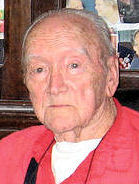 Willard H. "Bill" Bergeron, 92, passed away August 26, 2010 in San Antonio, Texas. He was born December 29, 1917. His wife Olga passed away in 2005. He is survived by one sister, four sons, grandchildren and great-grandchildren. His ashes will be interred at Fort Sam Houston National Cemetery in San Antonio. His life story appeared in the July 25, 2010 issue of "The Molesworth Pilot."
Willard H. "Bill" Bergeron, 92, passed away August 26, 2010 in San Antonio, Texas. He was born December 29, 1917. His wife Olga passed away in 2005. He is survived by one sister, four sons, grandchildren and great-grandchildren. His ashes will be interred at Fort Sam Houston National Cemetery in San Antonio. His life story appeared in the July 25, 2010 issue of "The Molesworth Pilot."
Bill was a copilot and pilot in the 360th Bomb Squadron. He flew two combat tours and was dispatched on 42 missions, many of them on Lead Crews. Bill was one of 46 men who participated in both the first and second Schweinfurt Missions. He was appointed 358th BS Operations Officer on 19 December 1944 and 358th BS Acting Commanding Officer on 30 March 1945.
|
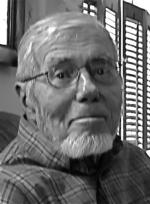 Stuart King Wood, of Yarmouthport, died early in the evening on Monday, July 26, 2010. He was 86 years old.
Born at home on leap year day, Feb. 29, 1924, in College Point, Queens, N.Y., the middle of three sons to Phoebe (Wolf) and Kenneth Barrow Wood, Stu was raised in the Landmark Town, Radburn, N.J.
Stuart King Wood, of Yarmouthport, died early in the evening on Monday, July 26, 2010. He was 86 years old.
Born at home on leap year day, Feb. 29, 1924, in College Point, Queens, N.Y., the middle of three sons to Phoebe (Wolf) and Kenneth Barrow Wood, Stu was raised in the Landmark Town, Radburn, N.J.
Educated at the Radburn School and graduating from nearby Ridgewood High School, Stu entered Norwich University's Army Air Corps Air Crew Training Program, and served overseas as a second lieutenant in the 8th Air Force 303rd Bomb Group (H) "Hell's Angels" 359th Squadron, navigating B-17s in nine missions over Germany in the final months of World War II out of Molesworth, England, and was awarded the Air Medal and an honorable discharge.
After the war, he joined the Williams College class of '50 for a year, then took a job driving a truck for B.F. Goodrich throughout the western half of the U.S. Returning to Radburn in '49, Stu fell in love with "Dee" Gates, married her on July 15, 1950, at the Church in Radburn, settled in their hometown and began raising a family. Throughout the 1950s and 60s, Stu held executive positions in marketing and promotion with U.S. Rubber, Avon, the Amateur Athletic Union, American Cyanamid, and Pfitzer International's Coty division. In 1971, Stu moved the family to Cape Cod, purchased an old Captain's House, and became the owner and sole employee of Stuart K. Wood Fuels, delivering heating oil from his home-based business for the next 20 years. Since retiring in '95, Stu continued to work part time for the Cape Cod Regional Transit Authority as a dispatcher until 2007.
Stu lived to nurture, support and share in the interests, talents and achievements of his four children and three grandsons. Always a passionate lover of baseball, and a diehard Red Sox fan, he instilled a love of the game in them all. On July 17 of this year, joined by their large extended family, Stu and Dee celebrated their 60th wedding anniversary. He went to bed that night expressing his joy for the love, pride and gratitude he felt for Dee and the life they had built together, remarking how he was as happy and content as he'd ever been. Within days he passed into the great hereafter, surrounded by his family.
Stu will always be remembered for his unshakable optimism, timeless good looks, and beliefs in the Golden Rule and the fundamental goodness of the American way. His genuine interest in others, how he listened deeply and encouraged their dreams and ideas, especially those of his children and grandsons, remained active in him till the end. He was a good man and he will be missed.
Stu was predeceased by his parents and brothers, Kenneth Barrow Wood Jr. and Donald Wood; brother-in-law Charles (Muriel) Gates; sister-in-law Anne Wood; nephew Andrew Wood; and old friends Sherm, Munson, Ziggy, Carm, Stan, Skip and Butch. He is survived by his wife Dee; sister-in-law Bev; children Stuart King Wood Jr., Steven Wood and his partner Claudia Chartrand, Carol Anne Wood, and Mary Lou Wood; grandsons Thacher Taylor Wood, Samuel King Wood, and Nicholas Stuart Rhodes; as well as many nieces and nephews.
A graveside service is planned for Oct. 2 at Woodside Cemetery, followed by a celebration of Stu's life at his home in Yarmouthport for all who would like to join in his fond farewell.
In lieu of flowers, donations can be made to the 8th Air Force Historical Society at 8thafhs.org.
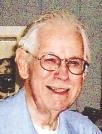 Henry L. Armstrong II, 88, of Newtown Square and West Chester, died on Aug. 23, 2010, at his home.
Henry served in the U.S. Air Force during World War II and was awarded the Purple Heart.
Henry L. Armstrong II, 88, of Newtown Square and West Chester, died on Aug. 23, 2010, at his home.
Henry served in the U.S. Air Force during World War II and was awarded the Purple Heart.
He was a draftsman for General Electric in Philadelphia. He was a volunteer at the Brandywine River Museum. An avid artist, Henry took numerous art classes at West Chester University. He was supervisor for 18 years of Birmingham Township as well as Justice of Peace in Birmingham Township. He built his house in Birmingham Township. He loved life, loved fishing and loved going to the Jersey Shore.
Henry was the husband of Anne K. (nee Miller) Armstrong and the deceased Esther I. (nee Irvin) Armstrong. He is survived by his children, Henry III (Linda) Armstrong, Irene Armstrong, Kathleen (John) Leber, Christine (Randy) Fenicle, Lorraine (Moises) Martinez, Jerry (Susan) Armstrong and Jennifer (Scott) Boorse; his stepchildren Anne Marie (James) Rowley and Donna (Stan) Szczygiel; 19 grandchildren and six great-grandchildren.
Relatives and friends are invited to his Mass of Christian Burial at 11 a.m. Friday, Aug. 27, at St. Anastasia Church, 3301 West Chester Pike, Newtown Square, where friends may visit the family in church from 10 to 11 a.m. Interment will be in Birmingham Lafayette Cemetery in West Chester. In lieu of flowers, contributions in his name to Homecare Network of Jefferson Health System, Hospice, 130 S. Bryn Mawr Ave., Bryn Mawr, PA 19010, would be appreciated.
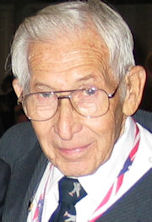 Jack P. Rencher was born March 25, 1921 in Los Angeles California. He grew up and spent his youth in the towns of Eagar and Springerville in northeastern Arizona. Jack passed on to a pain free world on August 20, 2010, in Boise, Idaho.
Jack P. Rencher was born March 25, 1921 in Los Angeles California. He grew up and spent his youth in the towns of Eagar and Springerville in northeastern Arizona. Jack passed on to a pain free world on August 20, 2010, in Boise, Idaho.
Jack was the first born of Irene and Guy B. Rencher. In 1945, Jack met and fell in love with his wife, Louise Schlotterbeck, a US Army Medical Corps Hospital Dietitian at Brooke General Hospital in San Antonio, Texas. Jack and Louise married in October of 1947 and raised three sons, Jack, Brian and Gordon. He was preceded in his death by his wife of 51 years, Louise Rencher, and his oldest son Jack, both in the spring of 1999. He is survived by his daughter-in-law, Corinne and Tom Janstrom, and Jack's children, David and Leah (Natalie), all of Boise; sons Brian and Monica Rencher of Boise; Gordon and his children Brooke, Jillian and Colin and their mother Kristin Rencher, all of Portland Oregon; sister Gladys and Roger Ashton, of Brookings, Oregon; brother, Frank and Georgia Rencher, of Kooskia, Idaho; and sister in law, Janice Rainey of Milford, Connecticut and many nieces and nephews.
Jack spent his youth in northern Arizona at various jobs, including running a trap line, delivering for Western Union Telegraph, serving as a bodyguard for a professional gambler, and working as mechanic and heavy equipment operator at a copper mine. When World War II started Jack enlisted in the Army Air Corps with the goal of flying fighters. After training to become a pilot, he became an instructor in P-38 fighters. He was subsequently trained to fly B-17 bombers and spent a year flying gunnery training at Yuma AZ. In 1944, he was transferred to the 303rd Bomb Group, stationed in Molesworth, England. He flew 35 combat missions over Germany with his last mission coming on December 24, 1944 during the Battle of the Bulge.
In Jack's later years he was very active in the 303rd Hells Angels bomb group organization. Some of his closest friends later in life were and are members of the 303rd. One of his close friends, Harry Gobrecht, who passed on August 10, 2010, shared with Jack the self-appointed title of "The Best Damn 4 Engine Pilot in the Army Air Corps." No one seems to argue that point.
After World War II, Jack and Louise and young son Jack moved to Idaho with the goal of settling in Emmett. But the old Army ambulance that they were driving broke down in Boise and they never made it to Emmett. That first winter in Boise, Jack took a job selling Kirby vacuum cleaners and he found his gift for sales. Jack also started a mechanic and repair shop in Meridian for a few years before starting Western Real Estate in Boise. Jack founded Technichem Corp. in 1968, a chemical and detergent company that is still operating today. Jack had a gift for sales from vacuum cleaners, real estate, chemicals, to cars and motorcycles. He always had his eyes open for a bargain in anything he bought or sold.
The family would like to thank Beth Levanger for her loving efforts in caring for Jack at home, and the hospitals' staffs that cared for Jack during his last days for making them as peaceful as possible. Services will be held at the LDS Castle Park Ward, 5900 Castle Drive in Boise on Saturday, August 28. A viewing will begin at 9:00 am and funeral services at 11:00 am. Internment will be at Dry Creek Cemetery following the service Services are under the direction of Summers Funeral Homes, Boise Chapel. In lieu of flowers please make a donation to your favorite charity or to the 303rd Bomb Group newsletter www.303rdbg.com.
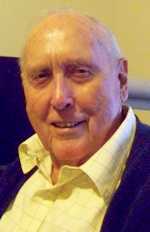 Earl Newton Thomas, 88, died on August 20th after an extended illness
at his home in Peachtree City surrounded by members of his family.
Earl Newton Thomas, 88, died on August 20th after an extended illness
at his home in Peachtree City surrounded by members of his family.
Thomas was a retired airlines pilot and a decorated combat veteran of World War II. He and his family had settled in the Atlanta metro area when he took a position with Delta Airlines in 1949.
Born in Bluefield West Virginia on November 16th, 1921, Thomas grew up in Roanoke, Virginia where he was a high school athlete with considerable talent; he played football, basketball and baseball.
When World War II began, Thomas joined the Army National Guard. His unit was called to active duty when the U.S entered the war. At that time, Thomas applied for duty as an aviation cadet thus beginning a career in flying. Thomas completed basic aviation training and advanced training in the B-17 “Flying Fortress” at a number of different bases in the U.S. He earned his commission as a Second Lieutenant and his pilot’s wings in May of 1943. In December, 1943 he ferried one of the big bombers to the European Theater of Operations--the air war in Europe.
Upon arrival in the United Kingdom, He was permanently assigned to the 303rd Bombardment Group (Heavy) at RAF Molesworth, commonly known as the “Hell’s Angels.” During his tour, Thomas flew 33 credited combat missions in the B-17 including bombing support for the D-Day invasion at Normandy.
In late 1944, as a newly promoted Captain, and a lead crew pilot, Thomas flew his last B-17 mission attacking oil refineries at Hamburg. For his role in that attack, he received the Distinguished Flying Cross (DFC). Due to his competence as a pilot and his leadership, all of his original crew completed their combat tours without injury. One of his co-pilots, Ed Miller, said, “Tommy was the best pilot I ever knew. He taught me just about everything I learned, more than in the formal schools.”
After finishing his B-17 time, instead of accepting reassignment back to lighter duties stateside, Thomas volunteered to fly the P-51 “Mustang” in an innovative new reconnaissance unit at Steeple Morden airfield. As one of the first bomber pilots to join the First Scouting Force, he would fly ten missions before being assigned as an flying instructor back home. He had earned the DFC with one oak leaf cluster and the Air Medal with four oak leaf clusters.
When the war ended, Thomas hired on with Trans-World-Airlines flying the DC-3 out of New York. It was there that his met his wife of 59 years, Patricia Northington Thomas. When he was later employed by Delta, he piloted at one time or another every aircraft the company used including the last plane he flew which was the L-1011. Thomas retired from Delta Airlines as a Captain in 1981 having amassed over 29,000 hours of flight time.
Thomas was a skilled golfer who, at age 40 in 1961, had the distinction of winning the first Club Championship at Lakeside Country Club and, at age 70 in 1991, winning the last Club Championship at that course. He also won the Delta Airlines Open several times. Shortly before he became ill at age 87, he won a Canongate Dogfight tournament. Always active after retirement, Thomas took part in the Bike Ride Across Georgia every year until he was 72 years old. Earlier, he had ridden his Honda Gold Wing motorcycle across the United Sates.
Besides his wife Patricia, Thomas is survived by children: Kathleen Bassett, Deborah Christainsen, Mary Thomas and John R.Thomas; grandchildren: Christine Sanderlin, Thomas Bassett, John Christainsen, Matthew Speiser, Jack Earl Thomas and Georgia Rose Thomas and great grand-son John Bruce.
A memorial service will take place Saturday, August 28 at Carmichael-Hemperley Funeral Home, 135 Senoia Road, Peachtree City Georgia 30269. In lieu of flowers, the family asks that any donations in his memory be sent to Evercare Hospice and Palliative Care, 3720 DaVincia Ct. Suite 300, Norcross. Georgia.
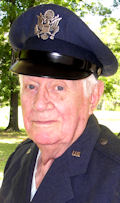 Major Ben Lee Connelly, who flew 30 missions as a B-17 pilot (2nd Lt. and 1st Lt.) with the 303rd BG "Hell's Angels", 360th BS, passed away on February 11, 2010 at his home in New Bern, North Carolina at the age of 88 years (born 12/21/1921). He was predeceased by his wife, Norma, 20 years earlier after 44 years of marriage. He never remarried and often stated that Norma was the only woman he would ever love and no one else could take her place. If you see her picture, you'll understand why. She was an intelligent, beautiful and elegant lady. He met her in Nebraska while undergoing B-17 flight training.
Major Ben Lee Connelly, who flew 30 missions as a B-17 pilot (2nd Lt. and 1st Lt.) with the 303rd BG "Hell's Angels", 360th BS, passed away on February 11, 2010 at his home in New Bern, North Carolina at the age of 88 years (born 12/21/1921). He was predeceased by his wife, Norma, 20 years earlier after 44 years of marriage. He never remarried and often stated that Norma was the only woman he would ever love and no one else could take her place. If you see her picture, you'll understand why. She was an intelligent, beautiful and elegant lady. He met her in Nebraska while undergoing B-17 flight training.
After the war, Dad went into the US Air Force Reserves where he attained the rank of Major. Although he had been a pre-med student at Wake Forest College prior to the war with aspirations of becoming a dentist, he never returned to college, but instead worked as a sales representative for a surgical supply company and drug representative for a pharmaceutical company. Afterwards he opened his own locksmithing business. As a result of his military and civilian careers, I often introduced my Dad to my friends as one of the original Hell's Angels, a "drug dealer", and a safe-cracker ... all true but not at all what they imagined until I explained things! Dad would often say that although he and his crews in the Hell's Angels BG were mean enough, he never had anything to do with the infamous motorcycle gang!
Dad was a Golden Gloves boxer in high school in Cary, NC near Raleigh. When the war broke out while he was in college, he went to enlist in the Army Air Corps to be a pilot but flunked the vision test. He started a regimen of eye exercises and said he "ate every damned carrot in the county" to improve his eyesight. When he went back to try again, he passed the test, enlisted at Fort Bragg, NC, in July 1942 at the age of 20 and went to basic flying training at LeMoore (Calif.) Army Air Field. He graduated as a pilot and was commissioned as a 2nd Lt. on Nov. 3, 1942 at Lowry Field in Denver, Colorado. I believe he received his B-17 training in Lincoln, Nebraska before being shipped overseas on a transport ship to Molesworth, England where it appears (according to your marvelous website) his first bombing mission there was Mission 214 on July 29, 1944.
My father was a dedicated Scoutmaster with the Boy Scouts of America and my brother and I (his only two children) are both Eagle Scouts. One of my two sons is a Eagle as well. He was very proud of his two boys and his grandsons. He was a great role model for us and the other many Scouts he influenced. He is greatly missed.
Thanks for letting me honor my Dad in this way and thanks for the tremendous effort you have put into this website that honors this country's finest heroes and greatest generation.
Richard Lee Connelly
Raleigh, NC 27603
![]()
Keeping the Legacy Alive,Hello Gary,
Harry Gobrecht and Joss Leclercq at RAF Molesworth in 2000
Thanks for the newsletter. I was sad to learn the death of Harry Gobrecht and Bill Dallas. I had been in correspondence with Harry in the 1990s about the 303rd B.G. crews that came down in my area (northern France). I sent him in return details from French archives and witnesses, more accurate in terms of geography than the U.S. records. I met Harry once, during the group visit to Molesworth in 2000. I traveled from France to meet him and some others, one being Bill Dallas, co-pilot of "Tennessee Hillbilly" which was shot down on 26th March 1944. One of his crewmates, George Arvanites, was also there and then crossed the Channel for a visit of the area where he came down on that fateful mission. Bill was to come too, but he changed his mind at the last minute.I remember I had asked Harry to bring a copy of "Might In Flight" as I wanted to buy a copy and especially have it signed by him, and the veterans attending (the highest ranking one was Lew Lyle). But the book sold off and so I never got my copy, having to content myself with the CD.
Regards from France, Joss Leclercq
I would like to be on the mailing list for the Molesworth Pilot. Your site is a great tribute to your dad and all members of the military that served then (and now). I lived near Brington from 62 - 64 while my father was stationed at Alconbury. I worked weekends at the Community Club on base as a glass washer/bar stocker and played pool with the young GIs (maybe a couple of years older than me at the time) stationed there then at the old Service Club that was run by some British ladies. At that time Molesworth was just a satellite base to RAF Alconbury but the UK GI jail was there as was Redistribution and Marketing where they sold old stuff from bases that were closing around the UK. During summers and on weekends when not away at the dormitory high school at Lakenheath my friends and I would roam all over that old base including the defunct flight line. That opening scene from 12 O'Clock High has always reminded me Molesworth. It has always held a fascination for me.There was rumor that one of the quonset huts was haunted in that one could hear people playing craps/dice but no one was ever there. Was there ever a story you heard of anyone clipping the top off the church in Old Weston? One of the Brit locals told me that but he may have been pulling my leg.
Again, thanks for a great job and the service you are providing. Sorry for rambling on.
Tom Mendell (USAF Retired -1990)
Gary,
I was just thinking how proud your dad would be of what you have accomplished with this website and newsletter. How you have not only kept the memory but kept the community together. That is a great gift to all.
Fondly, Stephanie Feyne

|
